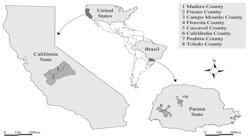ABSTRACT.
The distinction among Conyza canadensis, C. bonariensis, and C. sumatrensis is a challenge for weed science. In the current study, primers for microsatellite (SSR) loci were used to investigate the molecular divergence among the three species, the genetic structure of the populations at the molecular level and the level of genetic admixture among Conyza plants from southern Brazil. Twelve primers amplified well-defined DNA segments for all 88 samples of the three Conyza species. The estimated proportion of SSR polymorphic loci, number of alleles, and mean expected heterozygosity were higher in samples of C. bonariensis than in samples of C. sumatrensis or C. canadensis. Conyza canadensis was the species with the lowest molecular diversity. High genetic divergence was observed among the three species. The well-defined ancestral groups for each species led to the identification of samples of Conyza with ancestral genomes from the three species. Hybridization events between pairs of these species may have occurred in crop fields from southern Brazil. The high molecular diversity in resistant biotypes of C. sumatrensis indicated that these biotypes have a high potential to colonize new areas, which increases its potential as a weed.
Keywords:
horseweed; molecular divergence; SSR loci

 Thumbnail
Thumbnail
 Thumbnail
Thumbnail

